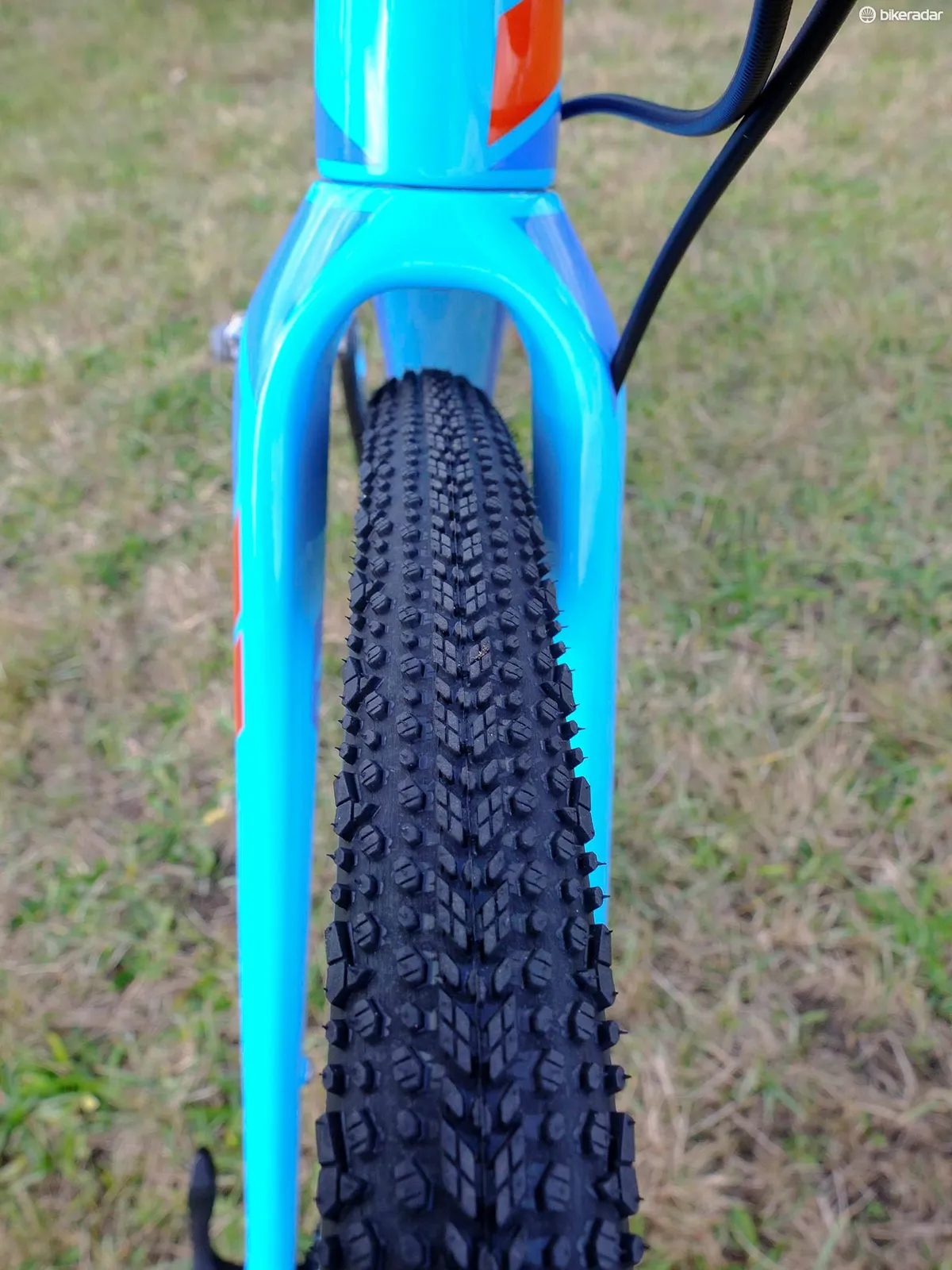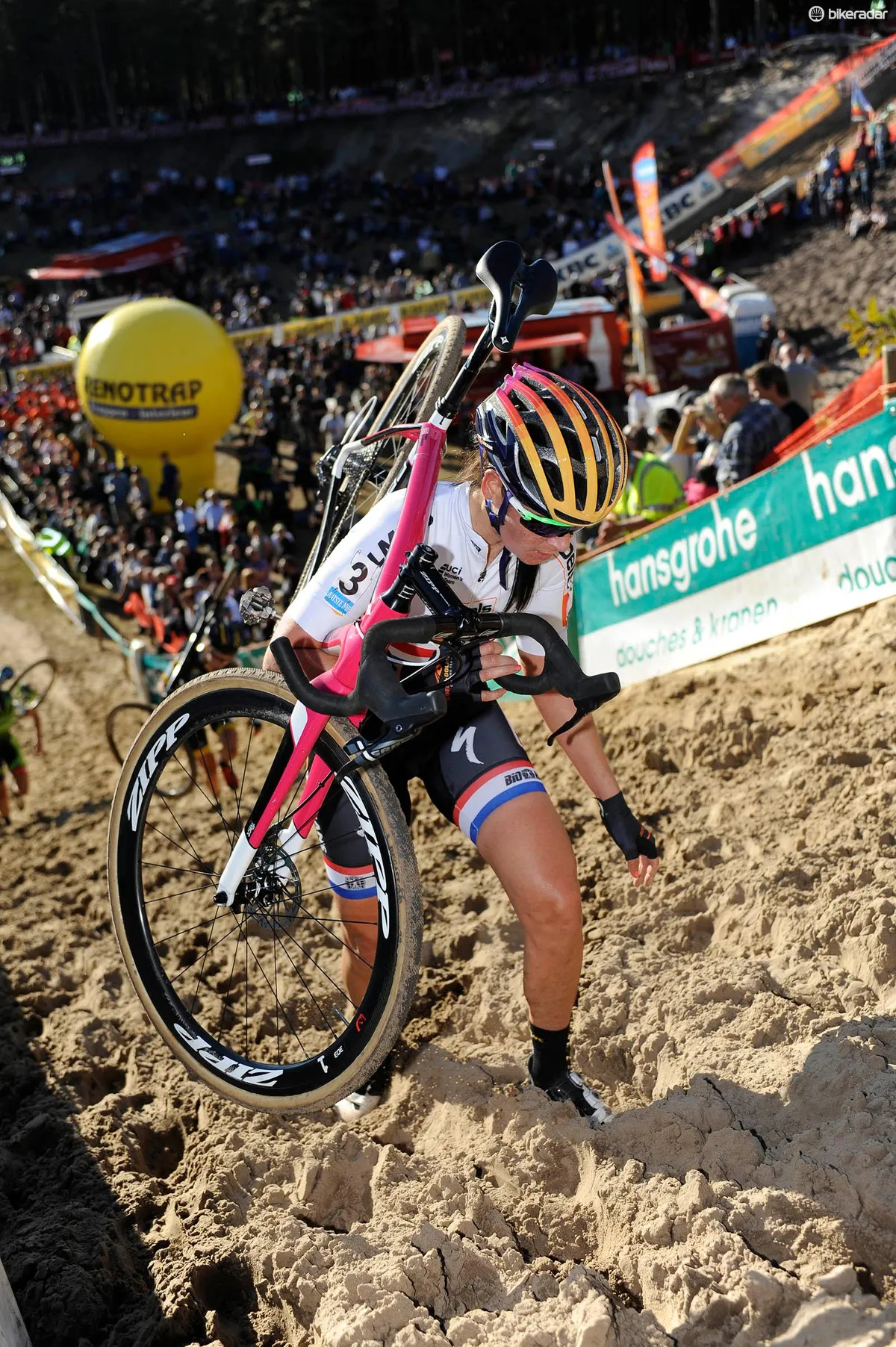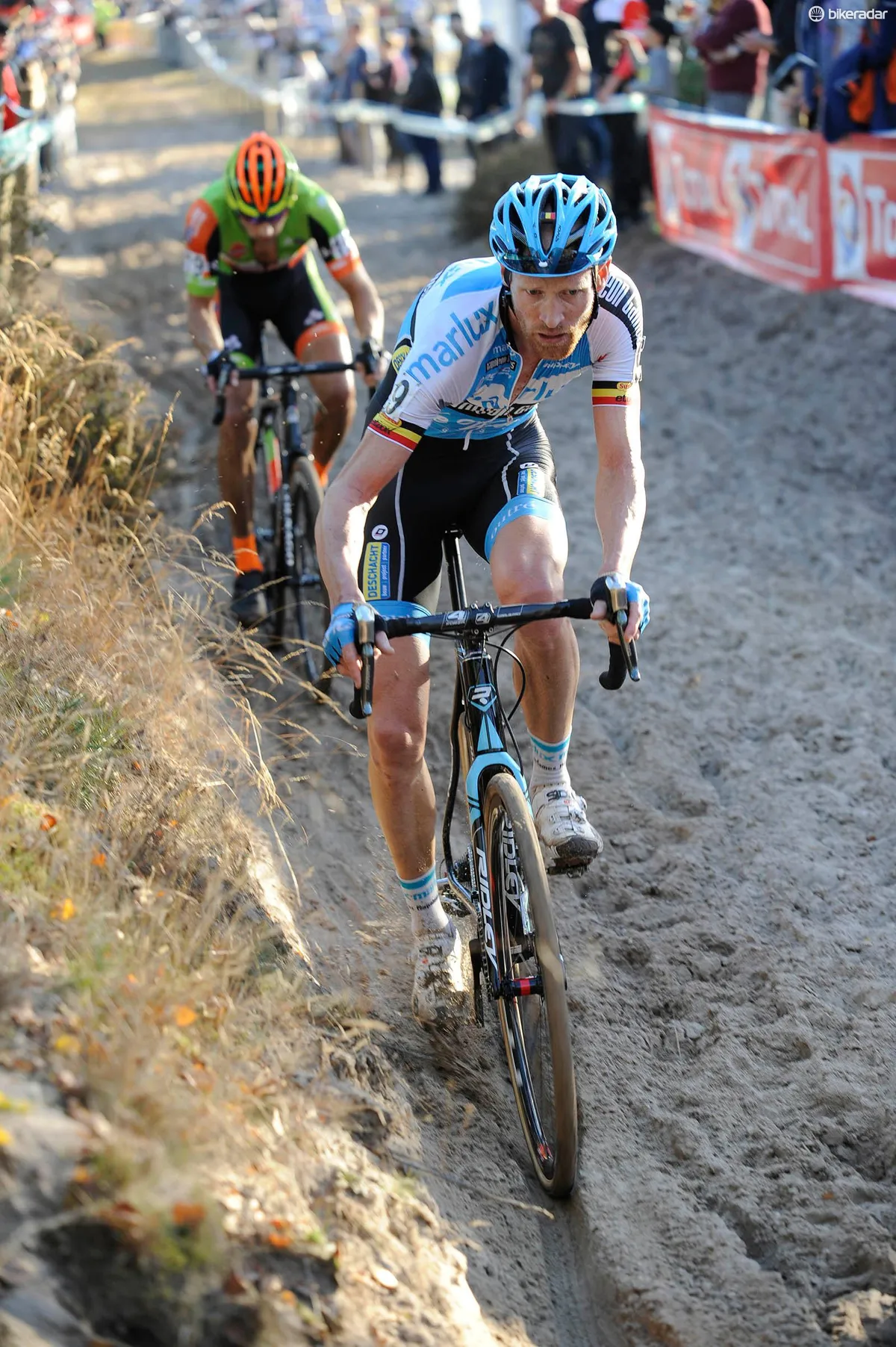A ’cross bike’s for cyclocross, a gravel bike’s for gravel and, since the bike industry powers that be tell us what each bike is for, then we must obey, and never shall the two paths cross.
- Best gravel and adventure bikes
- The best cyclocross bikes we've tested this year
- First-ride video: Ridley X-Trail on the roads and dirt of Colorado
But really, what is the difference between a cyclocross bike and a gravel bike? Both have drop bars, a road-style frame and wheels, fairly grippy but still narrow tyres, and disc brakes.
So I recently went to the Zonhoven Superprestige in Hasselt, Belgium and — gasp — test rode a Ridley X-Trail gravel bike on the notoriously tricky cyclocross circuit ahead of the pros.
- The course: Zonhoven Superprestige, which is a uniquely steep, deep sand challenge, majoring on power and very specific technical ability
- The quest: To see how a gravel bike from the self-professed Belgian masters of cyclocross would cope with one of the most challenging ’cross courses in the sport
- The horse: Ridley X-Trail Carbon Force 1 HDB, with 12mm thru-axles, SRAM Force 1, 46t chainring, 10-42 cassette, 140mm/160mm rotors, DT Swiss RR21 Dicut wheelset with Clement X’Plor MSO 36mm tubeless ready tyres, 4ZA finishing kit, Time ATAC pedals

Ridley's X-Trail Carbon was our horse for this course
Steep and deep
When invited to go and ride the notorious Superprestige cyclocross race circuit at Zonhoven in Belgium, the day before the pro race, I was excited and really quite nervous at the prospect. Having watched some of the world’s best cyclocross racers crash spectacularly on the fast, deep sand descents which make up this course’s most famous feature, there was some trepidation.
Coming from a UK cyclocross background, where the only sand on a racecourse is usually an old golf bunker on a disused fairway, or a school field long jump pit, extended riding in sand would be a steep learning curve for sure. As it turned out, it was steep, but mostly downhill!

My bike for this sandy odyssey was a Ridley X-Trail Carbon, fitted with a SRAM Force 1 drivetrain, in-house brand 4ZA bar, stem, seatpost and saddle, plus a DT Swiss RR21 Dicut wheelset shod with Clement X’Plor MSO 36m tyres.
Basically, the X-Trail’s geometry makes it a little more comfortable, with higher stack, average reach and a long wheelbase for stability
As with any ‘cross or gravel bike these days, one of the first things I check out is the gearing, as manufacturers still have differing ideas about what’s best. This X-Trail Carbon comes with a 46-tooth SRAM X-Sync chain ring and 10-42 cassette. In gear inch terms that’s a hugely wide range from 29” to 122”, covering everything from wall climbing to Alp descending, the only obvious concern being quite large jumps between gears.
Conventional cyclocross tyres are 33mm wide to comply with UCI maximum width regulations, although for the vast majority of us to whom UCI rules will never apply, almost anything goes, the only limit being choice. Would a wider tyre be better in the soft sand or would the fine block tread pattern reduce overall grip?
Considering the large volume tyres and big cassette, the bike’s 8.54kg total mass, including a pair of Time ATAC pedals is pretty competitive. A medium X-Trail Carbon frame is claimed to weigh 1,050g, prioritising impact resistance above feathery lightness, and it includes hidden custom mudguard mounts for added versatility.

So apart from the wider tyres and gearing, what makes this a gravel bike and not a cyclocross rig? Well using a couple of other Ridleys for comparison – the cyclocross X-Night SL and road endurance Fenix SL — we can show the geometry differences.
ArrayBasically, the X-Trail’s geometry makes it a little more comfortable, with higher stack, average reach and a long wheelbase for stability. That lower bottom bracket should help it feel more planted too, but at the expense of being a little compromised in cornering and off-camber pedal clearance.
The angles between the gravel and ‘cross bikes differ a little too. The X-Trail’s 73-degree seat tube and 71.5-degree head tube, compared to the X-Night’s 73.5 and 72, are steeper to suit the sport’s technical challenges. The X-Trail’s head tube is 25mm longer, which is more suited to longer rides, and allows more space to attach luggage up front, but Ridley has kept the X-Trail’s chainstay length to just 422mm, 3mm less than the equivalent-sized X-Night.
Into De Kuil
So on paper, there are obvious if subtle differences, but do they really make a difference on the course?
A brief spin around the grassy car park felt positive, so I headed for the tarmac start/finish straight. With the races still almost a day away, there were still numerous workers on and around the course making final preparations. This meant that care was occasionally needed and that some sandy sections were being churned up by feet rather than tyres.
A half-hearted sprint from the grid past the trucks installing the finish timing felt efficient, with great initial response and lateral stiffness that promised far more to come. Hitting the dirt, a small bank immediately kicked up several feet, feeling like a roller coaster, and then I was into a pair of wide 180-degree turns which exited in to the purpose-built flyover. Sadly this was closed to amateur traffic on Saturday, so I diverted through the pits and rejoined the course on the other side.
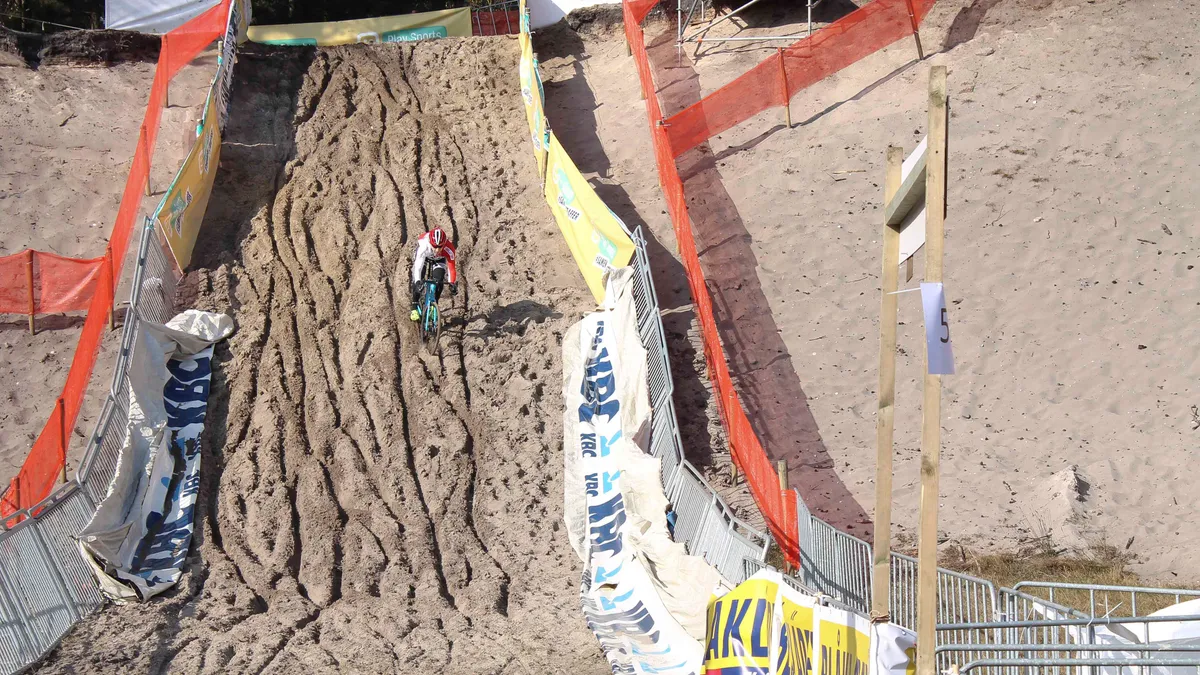
The heathland nature of the course and sandy soil made even the grassy sections quite tufty and incessantly bumpy. On the subtle drag upwards away from the pits I was glad of large tyres with low pressures, helping to soak up the firm bumps and finding extra grip in the corners — although a couple of rim taps on the ground told me I may have let out a tad too much air.
Even the easy-looking stretches felt quite draggy thanks to gradient and grass, and regular soft sand sections punished complacency. After a small chicane, the view ahead opened up and a large increase in people milling about around the course, plus huge viewing platforms, could only mean one thing: De Kuil.
De Kuil sounds more menacing than its English translation, ‘The Ditch’, which doesn’t quite do justice to the huge, crater-like sand pit that comprises Zonhoven’s main attraction.
Watching the race on TV doesn’t really prepare you for riding De Kuil. For one it’s not clear that the approach is completely unsighted, merely a blind, loose, sandy curve that ejects you in to a near 90-degree corner at the lip of the first and longest descent. This required complete commitment well before the drop. As a way of learning how a bike responds, getting it a bit loose is certainly one. Not necessarily a sensible one, but when in Belgium… The constant stream of course builders and public milling around at the top of the drop made the approach extra slow, since there was no chance for a helpful rut to form in the sand, and slow speed in deep sand is a recipe for instability.

With a small crowd smelling fear, and the inflatable crash barrier uninflated, I teetered around the corner and pointed the X-Trail downwards. At this point I was glad of its long wheelbase and top tube, and with as much weight as possible hanging off the back of the saddle I rapidly learnt how weird descending in deep sand feels. Over 25 years of racing cyclocross in British mud was of little help here, De Kuil feels more like surfing than cycling because there’s no apparent surface for the tyres to grip.
Grippy, spiked shoes came in to their own too, but still couldn’t prevent the feeling of two steps upward, one step down
With a gradient of around 25 percent, it was a daunting prospect, and once over the top there was no stopping, at least, not upright. Steering control was only effective when shifting body weight from side to side because any more than a few degrees of handlebar rotation would mean digging the front wheel in and a one-way ticket to a high side.
Here the X-Trail was super stable, helping to iron out my imperfect technique and ensuring I made it to the firm ground at the bottom for a left-right flick through the flat section and a sprint towards the climb back out. This comparatively little bank looks simple, but only one or two of the world’s best men ever manage to ride it each year, and then maybe only once or twice per race. I took the realistic charge-in-and-plan-to-dismount-before-halting approach, and once up on the crater’s rim enjoyed an easy ride for a quarter of its circumference before another 90-degree corner fired me in to the second descent.
If the first one felt steep, this one was steeper still, and with more sudden transitions between slope and flat. Whereas convention suggests following ruts where they exist, De Kuil’s descents are better tackled by ploughing your own furrow as the criss-crossing ruts from previous riders could take you places you really don’t want to be. Remember that uninflated crash barrier? Definitely faster, definitely sketchier, but accomplished without more than a runaway heart rate. A grassy corner below led to the final ascent, parallel to the first descent, but even longer since it extended in to the trees above the rim.
No matter how fast you approach this climb there’s no rolling up it, so a planned dismount, shouldering the bike and a long hike are the order of the day. The X-Trail’s 8.5kg weight was very welcome here and the flattened top tube made it easy to shoulder, which could also be of use when exploring the back of beyond.
My grippy, spiked Gaerne G-Stilo shoes came in to their own too, but still couldn’t prevent the feeling of two steps upward, one step down, as the soft sand slid away beneath my weight. What looks fairly innocuous even takes the pros over 30 seconds to climb and is that sort of steepness that leaves you somewhere between needing to reach out and touch the ground for support or standing up straight. It creates an awkward body position. I took a few tugs from the thankfully solid course-marking ropes and poles, and was relieved to reach the top.

While not blessed with race wheels or tyres, the X-Trail showed plenty of zip exiting slow corners and climbed the uneven stony track with great poise.
The most fun section began from the course’s highest point, as a patchy gravel trail wiggled downwards across the heath and through a fast right-hander and a shallow sandy section, before arriving back at the start. At speed, the Ridley really felt alive. Nimble enough to pick accurate lines and hop small obstructions, solid enough to brake hard in to the fast corner without deviating from its line, rail the bend and accelerate smartly away. Through this section there was little to separate the X-Trail from a ‘cross bike apart from a definite willingness to roll over almost anything and great stability.
Choices and conclusions
In stability terms, the X-Trail trumps a cyclocross bike, which you’d expect as it’s intended to carry luggage and no one wants a skittish steed when fully loaded in the wilds. In this Carbon build there’s next to no overall weight penalty that’ll sap strength, although as mentioned, the wheel/tyre combo isn’t designed for outright speed, but is built tough for swift adventuring. Clement’s X’Plor rubber is a great choice for most conditions outside of deep winter, with fine tread blocks that roll quickly on tarmac or hardpack, and sufficient shoulder grip to hold on in most loose corners.
Low-speed manoeuvrability is positive and precise, and the bike’s added length helps balance when things get gnarly. At high speeds off road it can be hustled through technical sections almost as quickly as a ‘crosser, front and rear thru-axles certainly improving solidity. Direction changes aren’t as urgent and the increased rotational mass means the X-Trail is less agile over technical terrain. But, there’s a definite comfort gain from the larger volume tyres, which in addition to the 27.2mm carbon seatpost and flattened seatstays, soak up plenty of vibration.
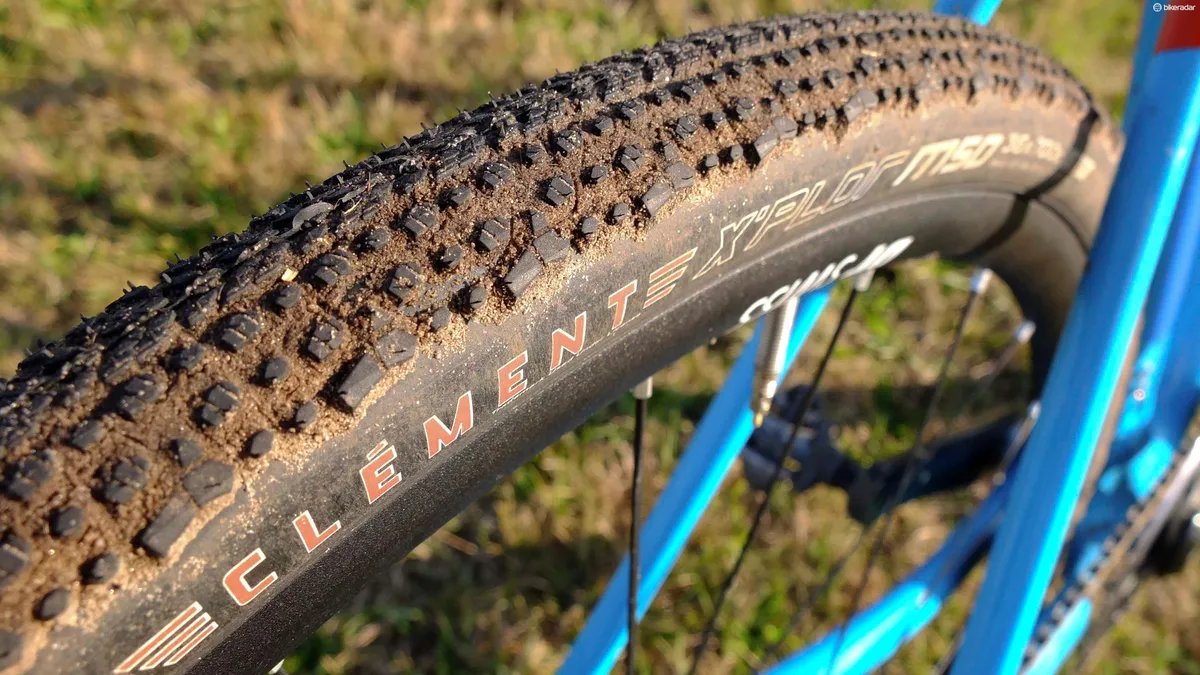
Apart from De Kuil, Zonhoven is a fairly flat course, although the surface often makes it feel anything but — and unless you have 450 Watts to repeatedly deploy around the course, it’s a very tough day out. This made it a fair test of the X-Trail’s gearing, and despite worrying about that chain ring size being a little optimistic, there was always a gear for the situation. If only there had been the power to make use of it…
Were slightly fatter tyres an advantage in deep sand? Without a direct comparison on the day, it’s hard to say if the sand surfing feeling was amplified because of their increased volume, but in more normal soft sand, bigger tyres are king. With some gravel bikes sporting tyres up to 50mm, the X-Trail’s limits of 38mm up front and 36mm out back could be seen as a little conservative, but on the trail it doesn’t feel it. Clearly I didn’t make use of the hidden rack and mudguard mounts, but they’re useful options and the frame’s intended to accept most strap-on bike-packing luggage too.
To answer the question we began with, yes, this gravel bike is perfectly capable of doing what a modern cyclocross bike can. Ultimately it’s less racy, but that few percent it gives up at the pointy end is gained back in versatility. And that — the idea of a take-it-anywhere bike like that of our childhood — is a far warmer and cosier thought than that of descending De Kuil again!
Click through the gallery above for a detailed look at the X-Trail and more race-day photos.









